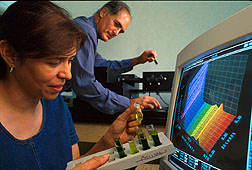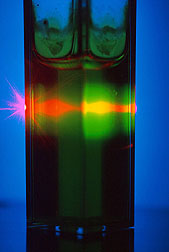The Degreening of Canola
|
|
 Postdoctoral research scientist Adriana Ortiz-Lopez uses a spectrophotometer to examine the different pigments contained in canola seed extracts while plant physiologist John Whitmarsh prepares a new sample for analysis. (K8717-6) |
In the world of plants, green is usually good . . . except in canola seeds. That's because too much green means too much chlorophyll has remained in the seed—meaning the seed hasn't matured. Freezing temperatures can prevent maturation, causing the seed to stay green. An early frost can cost North American canola growers up to $150 million. "The freezing interrupts chlorophyll breakdown in canola seeds," explains Agricultural Research Service plant physiologist C. John Whitmarsh. "Seeds can reach maturity and have a high oil content, but if they're green, their price drops." Seed crushers remove the green from the oil with bleaching clays, which produce an added expense and pose an environmental problem. Canola is an oilseed crop grown mainly in parts of western Canada, with some acreage in Ontario and the Pacific Northwest, north-central, and southeastern United States. Its yellow flowers produce pea-shaped pods that contain tiny seeds harvested for their oil. Canola oil contains omega 3 fatty acids, acclaimed for improving human immune and vascular systems. |
 Laser light is used to analyze material extracted from canola seeds. (K8718-2) |
"Ultimately, we may be able to provide industry with genetically altered canola plants tailor-made to tolerate freezing temperatures," says Whitmarsh, who is based at Urbana, Illinois. "Many plants break down chlorophyll even after a freeze. That's what happens in the fall when chlorophyll disappears and other leaf pigments become visible, creating spectacular fall foliage." Whitmarsh works collaboratively with Donald R. Ort, head of the ARS Photosynthesis Research Unit. Their lab experiments have shown that seed degreening in Arabidopsis—a close relative of canola—mimics canola's freeze sensitivity. Their goal is to identify Arabidopsis mutants that develop little or no seed chlorophyll, as well as other mutants that display early chlorophyll breakdown during seed maturation. To check seed degreening, postdoctoral research scientist Adriana Ortiz-Lopez puts plants in a growth chamber with freezing air blowing over them. She also keeps watch over other plants maintained at above-freezing temperatures. After a few weeks, she notes that seeds from plants exposed to freezing air are green, while those from plants held at slightly warmer temperatures are brown. Ortiz-Lopez uses chlorophyll fluorescence to illuminate the breakdown products of chlorophyll. She's looking for the stage in the degradation process that is blocked and is hoping to identify which proteins and genes are involved in chlorophyll degradation. The mutant seeds that degreen appear to be more freeze tolerant. The next step is to identify the modified genes that are responsible for tolerance to freezing temperatures in selected mutants. This accomplishment will open the door to cloning the mutated genes and introducing the freeze-tolerance genes into a wild plant. Ultimately, transgenic canola plants can be developed and tested for freeze tolerance. If successful, plants will produce seeds without chlorophyll, even after exposure to freezing temperatures. "Ten years ago, we did the basic research," says Whitmarsh. "Now our work demonstrates the possibility of going from basic molecular research to an applied solution."—By Linda McGraw, Agricultural Research Service Information Staff. This research is part of Plant Biological and Molecular Processes, an ARS National Program (#302) described on the World Wide Web at http://www.nps.ars.usda.gov/programs/cppvs.htm. C. John Whitmarsh and Adriana Ortiz-Lopez are in the USDA-ARS Photosynthesis Research Unit, University of Illinois, 190PABL, 1201 W. Gregory, Urbana, IL 61801-3838; phone (217) 333-2947, fax (217) 244-4419. |
|
"The Degreening of Canola" was published in the January 2000 issue of Agricultural Research magazine.
|
|






